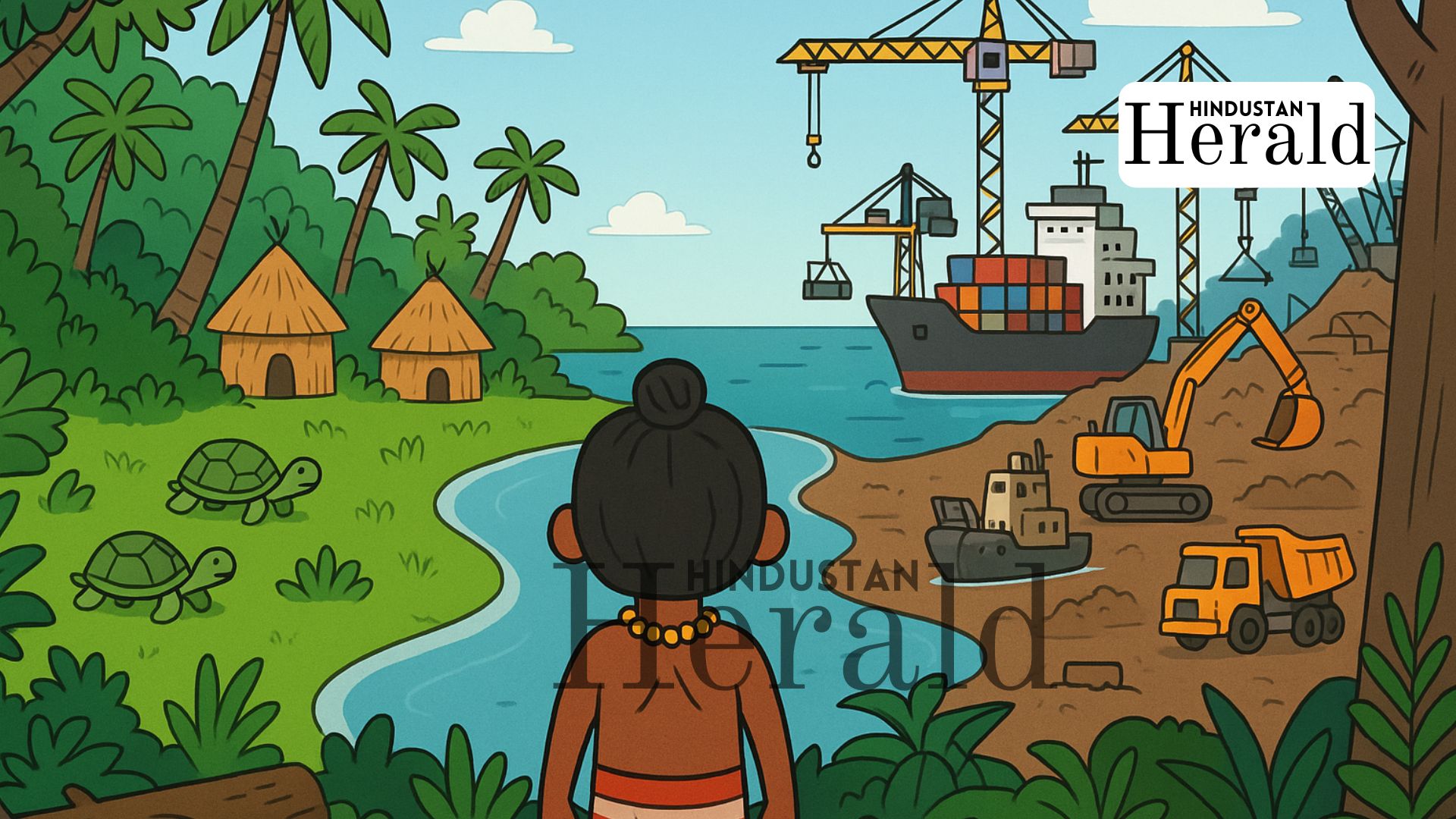Port Blair, October 17: The sea around Great Nicobar looks endless until the forest begins thick, dark, and alive. Now, the government wants to turn that silence into an international port. A new Singapore, they say. A “sustainable paradise.” The plan costs ₹92,000 crore and promises everything from jobs to strategy to pride. But the island isn’t waiting for prosperity. It’s bracing for bulldozers.
The Idea That Sounds Too Big
The blueprint could fill a manifesto.
A transshipment terminal for global cargo.
A Greenfield airport.
A power plant, a township, highways, and hotels.
Officials say Great Nicobar’s spot, just 40 kilometres from key shipping lanes, makes it perfect. The tone is confident, rehearsed. Words like “green,” “smart,” and “world-class” appear in every sentence. Still, you can’t talk of growth here without first talking of trees. Millions of them.
Where The Forest Stands In Protest
To clear ground for the port, 130 square kilometres of rainforest will go. That’s nearly a million trees by official count, though scientists who’ve seen the terrain say closer to a crore.
“You cut one here and a hundred fall silent,” says island researcher Pankaj Sekhsaria. He’s not speaking in metaphor. The canopy is so tight that when one giant goes down, sunlight kills what lives beneath.
The government has offered “compensatory afforestation” not on the island, but in the Aravalli hills of Haryana, 2,000 kilometres away. The plan reads almost like paa rody. Replace a wet jungle with a dry ridge and call it balance. “It’s like paying for a fish by planting a cactus,” jokes ecological economist Vijay Kolenjawadi.
Fast-Tracked Approvals
In 2021, Vimta Labs filed the Environmental Impact Assessment. More than four hundred objections followed. None slowed the process. By the next year, every clearance was in place environment, forest, and coastal.
Protected CRZ-1A zones, which covered coral and turtle nesting sites, were quietly re-tagged CRZ-1B. That single letter opened the coastline for concrete. When the National Green Tribunal decided to “re-examine” things, many of the officials who had issued the clearances ended up reviewing their own work.
The People Nobody Counts
The island isn’t empty. It never was. The Chompens, a nomadic tribe of barely two hundred, live deep inside the forest, still hunting and gathering. Contact with outsiders could finish them. The Nicobarese, who farm and fish along the coast, were moved to shelters after the 2004 tsunami and never fully returned. Their ancestral land is now being called “vacant” for the new township.
A 2021 letter from the Andaman and Nicobar administration promised to protect tribal rights and, in the same breath, allowed “necessary exemptions” for project execution. The National Commission for Scheduled Tribes called it a violation of the Forest Rights Act. Its chairperson, Harsh Chauhan, soon resigned.
“Protection here means paperwork,” says a local activist. “The rest is demolition.”
The Bay That Lost Its Sanctuary
Until recently, Galathea Bay was a sanctuary for leatherback turtles, the world’s largest and most endangered. Only about a thousand breeding females remain in the Indian Ocean. More than six hundred nested here last year alone.
Then, in January 2021, the Environment Ministry denotified the sanctuary to make space for the port just two weeks after signing its own plan to safeguard turtle habitats. When pressed under RTI, the Wildlife Institute of India admitted it had no scientific study on the impact.
“Mitigation will be done,” officials said. Nobody knows what that means.
A Shaking Foundation
Geology might be the project’s final warning. Great Nicobar sits on a live fault line. The 2004 tsunami dropped parts of it by three metres; the mangroves were almost wiped out. Since then, quakes rattle the island nearly every week.
Yet files from Delhi insist that “major events occur once in 400–750 years.” It reads less like science, more like hope.
Business Beneath The Flag
The government calls it a strategic asset. The contracts tell another story.
The project follows the Landlord Model that the state builds, and private firms operate. Among the bidders are Adani Ports, Essar, and Mega Engineering & Infrastructure Ltd.
“The pattern’s the same,” says journalist M. Rajshekhar. “Public risk, private profit wrapped in a tricolour.”
From Eight Thousand To Three And A Half Lakh
Barely 8,000 people live on Great Nicobar today. The plan imagines 3.5 lakh in thirty years. It’s not growth; it’s a transplant. A full-scale city on soil that cracks and floods with every tremor.
Even the official impact report concedes the island lacks fresh water and basic infrastructure. But paperwork moves faster than tides, and Delhi rarely looks back once a ribbon is promised.
The Pattern We Know Too Well
The slogans change, Make in India, Blue Economy, Green Growth, but the rhythm is familiar. Approve first, justify later. When opposition builds, call it “anti-development.” On Great Nicobar, that word development now sounds heavier than it should.
Counting What’s Left
Maybe the port will stand. Maybe the ships will come. But if an entire forest and its people vanish in the process, what kind of victory is that? As one Nicobarese elder said quietly after a recent public meeting, “You can build cities anywhere. You can’t rebuild an island.”
Stay ahead with Hindustan Herald — bringing you trusted news, sharp analysis, and stories that matter across Politics, Business, Technology, Sports, Entertainment, Lifestyle, and more.
Connect with us on Facebook, Instagram, X (Twitter), LinkedIn, YouTube, and join our Telegram community @hindustanherald for real-time updates.
Covers Indian politics, governance, and policy developments with over a decade of experience in political reporting.






